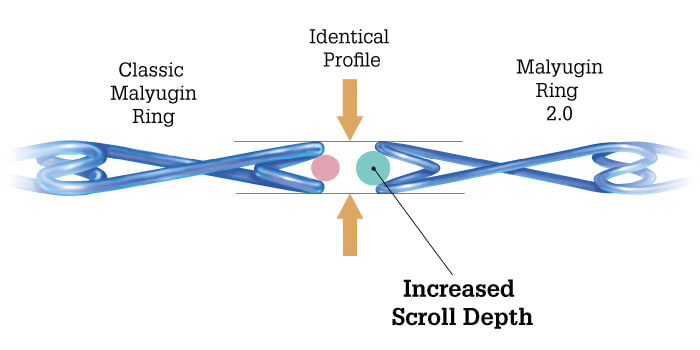
- The Malyugin Ring was designed by Boris Malyugin to address the problems associated with existing pupil expanders
- Manufactured from 5-0 polypropylene, the Malyugin Ring 2.0 is ideal for difficult-to-dilate pupils as it offers enhanced visualization of the anterior chamber
- The ring is inserted through a main corneal incision, reducing surgical trauma and minimizing the risk of contamination and postoperative inflammation
- Used correctly, the Malyugin Ring 2.0 can be beneficial to your practice and significantly speed up the cataract surgery process.
Good visualization of the lens is essential for safe, effective cataract surgery. This is best achieved when pupils are dilated to an adequate level during the procedure. But what happens when they are not? Inadequate pupil dilation can lead to surgical complications that all ophthalmic surgeons wants to avoid – iris damage, bleeding, prolapse, intraoperative floppy iris syndrome (IFIS), anterior capsule trauma and possible misalignment of the IOL. So what are the current approaches to small pupil management in complex cataract cases? Options include cutting the iris at the edge, stretching the pupil with two side instruments, heavy viscoelastic, use of iris hooks, medical dilation or using pupil expansion devices, such as Malyugin Ring 2.0. The Malyugin Ring was designed by Boris Malyugin (Professor of Ophthalmology, Deputy Director General at the S. Fyodorov Eye Microsurgery State Institution, Moscow, Russia) to address the problems associated with some pupil expanders, such as potential overstretching of the iris sphincter or extended surgery time (1). Developed to enhance cataract surgery in complicated small-pupil cases, the Malyugin Ring 2.0 is a safe and accurate device – and one that I like to use in both standard and complex cataract cases.
Easing complex cases
The reason the Malyugin Ring is the device of choice in complex cataract cases is that it expands space and enhances visualization. And with a high volume of complex cases, it is beneficial to have a device that is easy-to-use. The Ring is manufactured in two sizes – 6.25 mm and 7.0 mm – the 6.25 being universal for almost any case with small pupil, while the larger ring is useful in cases of IFIS (2).
Manufactured with 5-0 polypropylene, a thin (<1.0 mm) and flexible material, the ring is ideal for those difficult pupils requiring dilation, as it allows for better elasticity of the instrument. The Malyugin Ring 2.0 also features a larger scroll gap that eases the engagement of the iris and removal (Figure 1). There is a growing body of evidence supporting the use of the Malyugin Ring in various complicated cataract surgery scenarios, not limited to the small pupil management (3). It has been demonstrated that the Malyugin Ring can be used to clip the anterior capsulorhexis by two contralateral scrolls of the device to support weakened zonular apparatus and stabilize the capsular bag during small pupil phacoemulsification (4).
Case Study
Recently, a 55-year-old patient presented with a very hard white cataract and a history of angle-closure glaucoma. There was a very shallow anterior chamber (ACD 1.7 mm) to work with. With a small, difficult pupil, I needed to expand the pupil to create extra space. After cutting one main incision, I added heavy ophthalmic viscosurgical device (OVD, Healon 5, Johnson & Johnson Vision, Santa Ana, CA) and inserted the Malyugin Ring 2.0. The Ring is very thin, which affords the surgeon plenty of space to operate and is especially true when doing the capsulorhexis. After the insertion of the IOL, I removed the Ring easily. Because of this patient’s history, I detached the pupillary iris with the iris forceps following phaco surgery. Follow up consisted of prednisolone acetate ophthalmic suspension (eye drops) to prevent inflammation and evaluation the next day, due to the risk of elevated IOP.
Complicated cases like this would take much longer and have a higher risk of complications without the Malyugin Ring 2.0.
I have already mentioned how beneficial the Malyugin Ring 2.0 has been to my practice, but it is worth stressing that it is consistent, reliable and has made cataract surgery significantly more efficient. With the help of the Malyugin Ring 2.0, even complex cases are simplified. One of the more difficult circumstances, where surgeons often lack room to maneuver, is in patients with the pupils that starts to constrict right in the middle of the surgery. In cases such as IFIS, I use the Ring to give me space during the procedure. Insertion is simple – placed through the main corneal incision. Unlike multiple incisions, a single opening helps to reduce surgical trauma, minimizing the risk of contamination and postoperative inflammation. A single incision also acts as a time-saving additive in surgery. Its square shape and four circular scrolls with eight points of fixation ensure that an evenly dilated circular pupil is achieved, offering high levels of accuracy (5). The shape was developed with precision and safety in mind so there are no sharp edges. It is worth mentioning that the Malyugin Ring 2.0 is a single-use device, which ensures that it remains clean and undamaged by pre-operative sterilization processes.
Malyugin himself highlights the following benefits of the Ring 2.0 (7):
- It is designed to be implanted through a small 2.0 mm incision
- The new material (5-0 polypropylene) gives the device more flexibility, making it gentle on the iris tissue and allowing for controlled stretching and expansion of the pupil
- The increased scroll gap makes it much easier to engage the pupillary margin
- The Ring has a very low profile that does not restrict the movement of instruments in the anterior chamber
- During phacoemulsification there is no billowing or prolapsing of the iris, it is very stable during manipulation
- Because of the improved biomechanical properties of the 2.0 version, the ring is not only easy to implant but also much easier to remove from the eye.


In and out
With that in mind, here is my guide to efficient implantation and removal:
(Figure 2) Before implanting the ring, the viscoelastic is injected into the anterior chamber and under the iris. Then, the tip of the ring injector enters the anterior chamber through the main corneal incision. The thumb slide is then moved distally. The ring goes out of the injector at the same time as the distal scroll and two lateral scrolls engage the iris. After withdrawal of the injector from the anterior chamber, the distal scroll lies on the iris. Then a hook instrument is used to place the proximal scroll.
(Figure 3) The ring is removed through the main corneal incision. Using the manipulator, I first disengage the distal scroll followed by the proximal and lateral scrolls, lifting them above the iris plane. Then, I insert the injector and position the proximal scroll on the footplate. The scroll is caught by the injector hook and the ring is retracted using a sliding mechanism. Viscoelastic is removed and the pupil constricts spontaneously.
Strong and stable
I have used the Malyugin Ring for over five years now and found it to have a surprisingly small learning curve – and not just for me. My residents and trainees, many of whom are just beginning to learn about phacoemulsification, also find it easy to use. Though I prefer the new 2.0 design, because it is more stable in the eye than earlier generations – both can bring significant benefits to your practice.
As ophthalmologists, we know that maintaining adequate pupil dilation is vital for successful surgical outcomes in cataract surgery, which is why devices like the Malyugin Ring 2.0 are so important. By providing good dilation and iris stabilization, the Malyugin Ring takes a challenging procedure and helps make it much easier. It’s convenient, safe and simple to use. And it provides stable pupil expansion of the iris while importantly allowing the surgeon flexibility to move around intra-operatively. Anything that makes surgery easier for the patient and surgeon – without compromising safety or quality – is always very welcome!

References
- B Malyugin, “The Malyugin Ring in FLACS”, The Ophthalmologist. Available at: https://tinyurl.com/yxtntqas S Jacob, “The Malyugin Ring: The leading driving force of innovation is the necessity to solve a problem”, Eurotimes, Vol. 18, Issue 4. Available at: https://tinyurl.com/yxu9fhqg B Malyugin, “Cataract surgery in small pupils”, Indian J Ophthalmol, 65, 12, 1323–1328 (2017). Available at: https://tinyurl.com/yxptfahh S Zarei-Ghanavati et al., “Stabilizing the capsular bag and expanding the pupil with a pupil expansion device”, J Cataract Refract Surg, 41(9), 1801-3 (2015). PMID: 26471052. C Schweitzer, “Managing complications using the Malyugin ring” Ophthalmology Times. Available at: https://tinyurl.com/yyr7woac B Malyugin, “Surgeon: Malyugin ring helpful in small-pupil phacoemulsification”, Ocular Surgery News. Available at: https://tinyurl.com/yyydkw95 B Malyugin, “MicroSurgical Technology The new generation of the Malyugin Ring 2.0”. Available at: https://tinyurl.com/y6bgqb56
